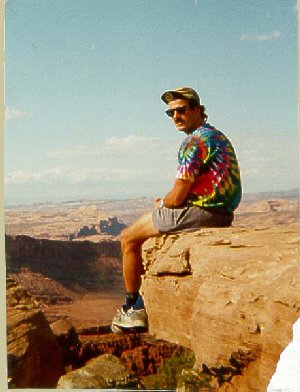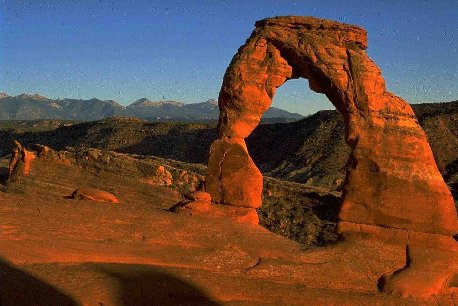Instead of a prayer, by Rod Nibbe
 Canyons. Red Rock canyons, vertical cinnamon walls of Jurassic sandstone. A river, ancient and present flows. Dinosaurs. A giant and a dwarf, I knew them, journeyed there with them. Only their spirits remain; they took nothing from the desert. In the bosom of canyons under the evening’s onyx sky, I listened to their tales of achievement and heard their confessions of life’s disappointments. Spires mesas arches and fossilized impressions of giant beasts humbled us.
Canyons. Red Rock canyons, vertical cinnamon walls of Jurassic sandstone. A river, ancient and present flows. Dinosaurs. A giant and a dwarf, I knew them, journeyed there with them. Only their spirits remain; they took nothing from the desert. In the bosom of canyons under the evening’s onyx sky, I listened to their tales of achievement and heard their confessions of life’s disappointments. Spires mesas arches and fossilized impressions of giant beasts humbled us.
The giant and the dwarf are gone now. No Petroglyph records their reverence for the land, no footprint is preserved marking their passage, no magnificent mesa remains evidencing their lives. What they left to the land has not been recorded except in the minds of those who traveled with them. Reminiscence brings nostalgia; remnant shadows in the memory, people and experience remembered. Nostalgia is a soliloquy in the mind like the spire on the desert floor. It is what remains that is important.
…
In 1982, Bob Gernant, then a professor of paleontology at the University of Wisconsin, led a caravan of Chevy Suburbans from Milwaukee to the tiny town of Vernal, Utah. Over twenty students had registered for the six week, two credit course : Geology-024 : A Look At the Earth. Professor Bob was a modern giant, he stood over six feet ten inches tall. He was part American Indian. Atop his head was an incongruous mop of silvery-white hair, always too long and hanging in his eyes, causing him constantly to fuss with it by flipping it to one side of his head or another. Professor Bob loved the canyon country of southeastern Utah. One could sense it in his peaceful disposition, hear it in his lucid geologic explanations of formation deposition, the creation of arches, canyons, mesas, and see it in his expression as he spoke of history and legend in the Red Rock country. Although not a religious man, I once heard him remark that the Canyon Lands was God’s country.
Vernal is home to the remarkable Dinosaur National Monument, it was the first scheduled stop. As we walked toward the visitor center I measured my understanding of the dinosaurs. I had finished four years of study in geology but the majority of students on the trip were not aspiring earth scientists. I tried to appear unimpressed by the excavation of dinosaur bones in progress at the rock outcrop, and prepared to field questions from the nursing student standing near me who had signed on for adventure and partial satisfaction of his curriculum’s natural science requirement. But I couldn’t look away from the bones.
The exposure of rock was 30 to 40 feet high, high enough to require scaffolding to facilitate the excavation, and about 100 feet wide. It was chilling. Goose bumps appeared on my arms, my gaze transfixed on the gnarled end of a huge bone beginning to poke out of the sandstone, barely recognizable as a femur. The gaze slipped into a trance as I wondered how those prehistoric creatures had met their fate at that place tens of millions of years ago. What had caused the death of these dinosaurs? And what had caused the sudden extinction of them all? My imagination re-assembled the bones and vivified a tyrannosaur loping across the paleo-landscape.
Professor Bob stood away from the viewing area engaged in a casual conversation with someone he appeared to know. There was a calm about him, he held an unmistakable reverence for that grave as if it were a sacred burial ground. He had been there before I thought, and had reached his conclusion concerning the fate of the dinosaurs. Jeff was nearby too. He was a diminutive man in stature, four feet ten inches tall, and a fellow geology major. He was smiling and gesturing at the outcrop, playing to the fascination of an impressionable nurse who was baffled by what she saw. Jeff was ebullient throughout the entire trip, he shared his surplus of excitement and vitality with all of us.
We drove in the Suburbans down the eastern border of Utah, stopping occasionally, where Professor Bob would unfold out of a cramped truck with an armful of poster-sized white placards. He would stand at roadside and use them as instructional aids to share his knowledge of Red Rock creation. His presentations were vivid – I studied him. Towering and confident, his ruddy complexion was burnt orange; set against the Red Rocks he was nearly indistinguishable from the ferruginous sandstone. I imagined him carved from a mesa, incarnated, and sent as a prophet to reveal the land’s secrets.
Often, I stood a distance from the group, feeling small relative to the remnants of erosion around me, listening to the desert or watching a lizard skitter across the peneplain floor. It was June, summertime in the Utah. It had seemed as if every day must be hot and dry because there was never a cloud in sight. But I knew that because the high desert had lifted at least five thousand feet above the sea, the winters there were cold and snow plentiful. That day the morning air was warm and welcome, dry and comfortable. As the sun climbed to its noon-time position, the Red Rock walls blushed rustic orange, then changed to cinnamon, then crimson. Any dew that may have formed in the crevasses of rocks, or under the petals of a few scattered desert wild flowers during the respite of cool evening air, had long since evaporated, yielding to the determination of the late morning sun. If one was outside at the precise moment of morning, evaporation would dazzle the nose with the sweetest smells the desert has to offer – Russian Olive, Pinion Pine, Desert Rose.
Back in the trucks we drove South to Moab. I don’t recall much of Moab during that trip, only that it was a small and unremarkable town. What I remember are the places we ventured to explore during the days. Places with unforgettable names, like Dead Horse Point, so named because many wild horses had dehydrated and died there, trying in vain to find a path to the water in the canyon below; or Needles Overlook, where the eye is treated to isolated vertical spires of rock and pastel mesas, left stranded on the land, separated from neighboring rocks by a whimsical sculptor – the Colorado river. Standing on the highest overlooks, the landscape appeared eerie, without dimension, defying one’s ability to estimate distance or size, but we never stopped trying. I had never been in the presence of geology that had been cut open to expose the rings of time, unequivocal as it was in the endless stratified layers of Red Rock.

Inside Arches National Park Professor Bob chronicled the evolution of an arch. He described how a small hole in a narrow wall of rock became larger and larger, yielding to the forces of wind, water, and ice, until only a fragile arch remained spanning the hole. At Canyon Lands National Park, with a baritone voice rich and styled like that of a raconteur, he elucidated the history of deposition of each formation as though he had lived millions of years and witnessed it all. Standing on the mesas, hiking around the arches and puzzling over the tilted strata was humbling for me. In that natural laboratory away from textbooks, I understood little of the processes which had carved the land forms. The birth of an arch was explicable and easy to understand, and the reasons the Colorado River had chosen its path were within my grasp. But what of the tilted rocks? And what about Upheaval Dome? What really happened there?
We stopped at Upheaval Dome where Professor Bob animated the two prevailing theories competing to explain the origin of that geologic conundrum. Upheaval Dome is a vast circular expanse of collapsed rocks rimmed by a ridge about 8 miles in circumference. Imagine a bowl turned upside down with its center punched in. One theory holds the “upside down bowl” was filled with salt, which dissolved in water over time, leaving the overlying rocks unsupported until finally they collapsed. Another theory holds that the “upside down bowl” never existed. Instead, it’s postulated that Upheaval Dome is the result of a collision. As evidence for that theory, historical geology sleuths point to an unusual variety of minerals in and around the dome associated with high temperatures and pressures, the consequence of a meteorite that smashed into the earth. That’s the theory Jeff preferred and the one he tried to coax the nurses into believing. I marveled at the size of that feature and walked away humbled by a land that does not easily give up its mysteries.
We spent the final four days of the trip rafting down the Colorado River, the academic portion was over. We floated a mostly placid river, finding hazard only once inside Cataract Canyon when bouncing off exposed rocks in the dangerously low water of Black Betty rapids. Professor Bob’s eyes grew larger than two full moons when the rapids pinned our raft against a tilted rock nearly flipping us over. When the sun dropped out of sight we searched for a clearing on the banks of the river and established camp. A modest campfire was built for cooking, we would eat and then settle back against our duffels and talk for hours while watching the fire dissolve into red and white embers. We never slept in tents, only in sleeping bags, falling asleep while watching moon shadows on the canyon walls. When we stopped for lunch in the heat of day, we’d scramble up unnamed gorges which wound their way uphill from the river bottom to mysterious places we never reached – they just kept going. We all felt like children again. We discovered waterfalls and took mock showers, we found tiny frogs in small pools of warm water and raced up and down the rocks eager to see what the next turn in the gorge would reveal. Jeff and I dove off cliffs into Lake Powell and tanned under a sunny sky on huge slabs of flat sandstone. At the end of the trip we left the rafts at the south end of the lake. Some folks who worked for the company which guided us down the river had driven the trucks there to meet us. We stuffed the gear we carried on the river in the back of the trucks and returned to Wisconsin.
After that trip I pined for a return to Utah. I wanted to spend more time there doing nothing more than hiking through the canyons and wandering around in the vast open spaces created by erosion. The yearning lessened a bit over the years, but my memory of that experience in Red Rock country and the people who shared it with me never did.
Within a year after returning to Wisconsin, Jeff died. He was found in his car slumped in the front seat having suffocated when a fragment of food became lodged in his trachea. I graduated and moved away, but two years later I heard the sad news that Professor Bob had died too. I never discovered how, only that he had gone suddenly, early in his 50’s. The day I heard the news, I searched for the slides I had taken on the trip, dropped them into the carousel and viewed them one by one.
…
Over ten years later I returned to Moab with the same anticipation one feels when meeting an old friend. I stayed at a bed and breakfast in the Spanish Valley area five miles north of main street in “downtown” Moab. Natural springs bubble to the surface in the Spanish Valley, creating an oasis of lushness in an otherwise arid desert. Moab had grown since my first trip, catering to the barrage of tourists that visit there each year.
The first evening it rained hard. The following morning I stepped outside to assemble my bicycle and instantly I smelled the sweet fragrance of blooming Russian Olive trees. The morning sun was pleasant and warm, slowly making its way into a cloudless sky, illuminating the Red Rock walls of sheer cliff faces. Standing alone, I didn’t move, my memory was refreshed with the experiences I enjoyed there years ago. I had smiled thinking that Jeff and Professor Bob would be pleased with that day in the desert.
Two friends had rendezvoused there with me. We rode mountain bikes and I introduced them to the vistas from Dead Horse Point and Needles Overlook. One day after a long arduous climb on our bikes to the summit of Porcupine Rim we stopped to rest. I moved to a precipice and sat alone. My legs dangled a thousand feet above the peneplain floor. To my right the lush La Sal mountains stood ruggedly juxtaposed to a parched cathedral – Castle Valley. I ruminated on Professor Bob’s roadside lectures, remembered Jeff, folded my hands and mused over one possible explanation for what I could see
Each layer added to the burden of those beneath it, compacting them and forcing out water in the spaces between sand grains. And underneath it all, thick deposits of salt, talc, and gypsum – minerals left behind as testimony to an even older sea that had become trapped on the continent, and when unable to retreat, simply evaporated. All of this occurred quietly – tens of millions of years before the consciousness of any sentient being could witness its passing.
But the dinosaurs were here. For much of this time, this place was their home, a place where they roamed unchallenged, dominated and prevailed without equal. Creatures so awesome and unimaginably large, it is a mystery that so little record remains of their existence. In a geologic blink of an eye, inexplicably, they vanished. Nothing but a few fossilized impressions of footprints in the rock recording their trek across the land, or the finality of their death marked by the random preservation of a pile of bones.
Slowly the land began to rise under the influence of enormous subsurface forces, causing the final retreat of the sea from the continent, leaving behind a legacy of millions of years of compacted sand and limestone. With the sea gone, the land continued its transformation. Under the weight of the rocks above it, and pressed by the forces below it, the malleable salt layers began to flow laterally, squeezed like clay between the hands of a potter. With no place else to go, it exploited weaknesses in the rocks above it, creating cracks and fractures as it forced a path to the surface. As rivers and streams discovered the cracks, they gave way to channels, and then widened further into shallow valleys. Unequal forces persisted, further tilting the rocks which increased the gradient of the rivers.
Finally, orphaned by the retreat of the sea and nearly surrounded by mountains, this place became dry and increasingly desert-like. Rushing faster the water gouged the rock more deeply, creating gaping chasms and an endless number of interconnected canyons and gorges. And with gentle persistence it continues to this day. After a very long life, this place matured into a fragile architecture of incomparable beauty, created by a unique and improbable collaboration of wind, water and tectonism.
So I will tread a track in Red Rock country, walk a distance and leave a footprint. And maybe, just maybe, the passage of time will fossilize my journey like that of the dinosaurs. My track will be proof of that geologic insignificant instant in time when I walked the land and gazed with awe at its splendor.
This essay was published in the 1997 University of Alaska-Anchorage literary magazine – The Inklings
